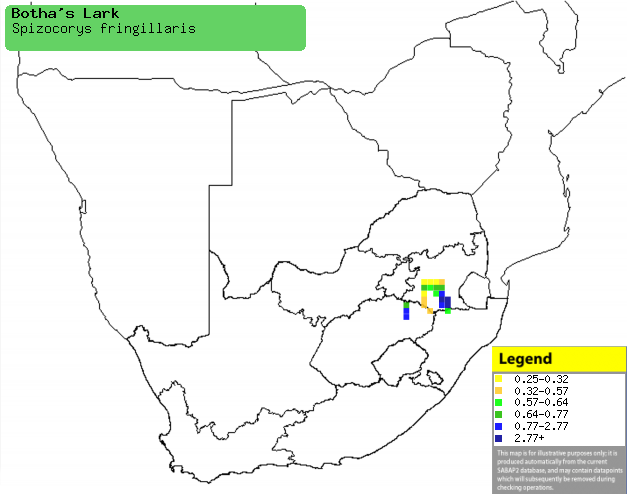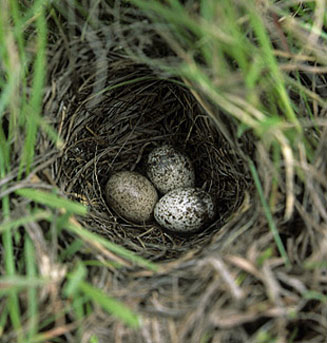|
Spizocorys fringillaris
(Botha's lark)
Vaalrivierlewerik [Afrikaans]; Botha-leeuwerik [Dutch];
Alouette de Botha [French]; Finkenlerche [German]; Cotovia de Botha
[Portuguese]
Life
> Eukaryotes >
Opisthokonta
> Metazoa (animals) >
Bilateria >
Deuterostomia > Chordata >
Craniata > Vertebrata (vertebrates) > Gnathostomata (jawed
vertebrates) > Teleostomi (teleost fish) > Osteichthyes (bony fish) > Class:
Sarcopterygii (lobe-finned
fish) > Stegocephalia (terrestrial
vertebrates) > Tetrapoda
(four-legged vertebrates) > Reptiliomorpha > Amniota >
Reptilia (reptiles) >
Romeriida > Diapsida > Archosauromorpha > Archosauria >
Dinosauria
(dinosaurs) > Saurischia > Theropoda (bipedal predatory dinosaurs) >
Coelurosauria > Maniraptora > Aves
(birds) >
Order: Passeriformes > Family: Alaudidae
> Genus: Spizocorys
Distribution and habitat
Endemic to South Africa, only occurring in the heavily
grazed upland grassland of Mpumalanga and the Free State. It avoids poorly
drained areas, long grass in valley bottoms, planted pastures, rocky areas and
croplands.
|
 |
|
Distribution of Botha's lark in southern Africa,
based on statistical smoothing of the records from first SA Bird Atlas
Project (©
Animal Demography unit, University of
Cape Town; smoothing by Birgit Erni and Francesca Little). Colours range
from dark blue (most common) through to yellow (least common).
See here for the latest distribution
from the SABAP2. |
Food
It eats invertebrates and seeds, briskly foraging on the
ground, plucking food items from soil and occasionally hawking prey aerially. The following food items have been recorded
in its diet:
Breeding
- The nest is a cup built of dry grass and lined with finer material, such
as fine grass, hair and wool. It is typically placed in an excavated hole in
the ground between grass tufts, or occasionally at the base of a shrub or
amongst sheep dung.
 |
|
|
Botha's lark nest with eggs, Wakkerstroom, South
Africa. [photo Warwick Tarboton ©] |
|
- Egg-laying season is from October-January.
- It lays 2-3 eggs, which are incubated by both sexes for roughly 13 days.
- The chicks are fed by both parents on a diet of insects (mainly
grasshoppers), leaving the nest after about 11-15 days.
Threats
Endangered, as it only occurs in localised,
unprotected areas and its total population is roughly estimated to be only
1000-5000 individuals.
References
-
Hockey PAR, Dean WRJ and Ryan PG 2005. Roberts
- Birds of southern Africa, VIIth ed. The Trustees of the John Voelcker
Bird Book Fund, Cape Town.
|
